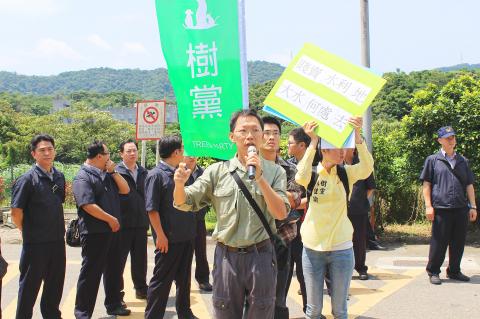Residents of Singuang Borough (新光) in Taipei’s Nangang District (南港) yesterday asked Taipei Mayor Ko Wen-je (柯文哲) to buy back what they said was an illegally acquired plot of land and a flood-relief channel beside the Sinjhuang Pond (新庄埤), to protect public safety in the flood-prone area.
Carrying banners and a petition, borough residents and members of the Trees Party yesterday morning congregated in a park overlooking the natural pond about 30 minutes before Ko’s motorcade was scheduled to pass by.
However, Ko’s chauffeur drove right past the crowd and the mayor began an inspection of the No. 202 Arsenal at the nearby Guanghua Military Complex without meeting the petitioners.

Photo: Sean Lin, Taipei Times
Upset with the situation, the demonstrators followed Ko’s motorcade to the gates of the military base, with party members and several residents saying that officials in Ko’s administration had received information before the event, but deliberately drove past, so the mayor would not have to address what petitioners described as a conflict of interests.
Sinjhuang Pond Protection Alliance spokesperson Cho Chi-ping (卓基坪) accused the administration of former Taipei mayor Hau Lung-bin (郝龍斌) of illegal profiteering on behalf of the Chi-Sing Irrigation Association and Hsin Lu Co, a construction company.
Hau’s administration abolished a lane on the plot after saying that a flood-relief channel that runs through it “was not serving its purpose well,” Cho said.
The move allowed the association, which had authority over the lane — which was connected to a plot Hsin Lu needed for construction — to sell it, Cho said.
The lane is now fenced off with a section of the canal, which together form part of Hsin Lu’s construction site for an apartment building.
A borough resident surnamed Liu (劉) said that Hau’s administration contravened a city bylaw related to lane abolition.
According to the bylaw, the city government should have indicated which lane it intended to abolish after performing an assessment, but Hau’s administration simply identified the land on which the lane is situated and seized it, Liu said.
He said the land seizure would exacerbate flooding during typhoons.
Now that Hsin Lu owns a stretch of the channel, dredging could be impeded as the city government no longer has authority over the facility, he said.
Liu said the borough suffered severe flooding when Typhoon Nari hit in 2001, with water up to a story high and the Kunyang MRT Station entirely submerged.
The channel is the only flood relief channel connected to Sinjhuang Pond and is pivotal to protecting residents’ safety, Cho said, adding that it should not have been compromised just because of supposed insufficient capacity.
The Nangang MRT station is connected to Taiwan Railways Adminstration lines, and is set to be linked to the Taiwan High Speed Rail, Cho said.
Losses would number in the billions of New Taiwan dollars if another major flood should occur, he said.
The demonstrators called on the city government to buy back the lane and designate the plot a wetland, which would prohibit future construction.
Taipei Deputy Mayor Teng Chia-chi (鄧家基) said the city government would examine all files relating to the case to probe any possible illegality, and that it would dutifully address residents’ appeals.

Taiwan is to commence mass production of the Tien Kung (天弓, “Sky Bow”) III, IV and V missiles by the second quarter of this year if the legislature approves the government’s NT$1.25 trillion (US$39.78 billion) special defense budget, an official said yesterday. Commenting on condition of anonymity, a defense official with knowledge of the matter said that the advanced systems are expected to provide crucial capabilities against ballistic and cruise missiles for the proposed “T-Dome,” an advanced, multi-layered air defense network. The Tien Kung III is an air defense missile with a maximum interception altitude of 35km. The Tien Kung IV and V

The disruption of 941 flights in and out of Taiwan due to China’s large-scale military exercises was no accident, but rather the result of a “quasi-blockade” used to simulate creating the air and sea routes needed for an amphibious landing, a military expert said. The disruptions occurred on Tuesday and lasted about 10 hours as China conducted live-fire drills in the Taiwan Strait. The Civil Aviation Administration (CAA) said the exercises affected 857 international flights and 84 domestic flights, affecting more than 100,000 travelers. Su Tzu-yun (蘇紫雲), a research fellow at the government-sponsored Institute for National Defense and Security Research, said the air

Taiwan lacks effective and cost-efficient armaments to intercept rockets, making the planned “T-Dome” interception system necessary, two experts said on Tuesday. The concerns were raised after China’s military fired two waves of rockets during live-fire drills around Taiwan on Tuesday, part of two-day exercises code-named “Justice Mission 2025.” The first wave involved 17 rockets launched at 9am from Pingtan in China’s Fujian Province, according to Lieutenant General Hsieh Jih-sheng (謝日升) of the Office of the Deputy Chief of the General Staff for Intelligence at the Ministry of National Defense. Those rockets landed 70 nautical miles (129.6km) northeast of Keelung without flying over Taiwan,

A strong continental cold air mass is to bring pollutants to Taiwan from tomorrow, the Ministry of Environment said today, as it issued an “orange” air quality alert for most of the country. All of Taiwan except for Hualien and Taitung counties is to be under an “orange” air quality alert tomorrow, indicating air quality that is unhealthy for sensitive groups. In China, areas from Shandong to Shanghai have been enveloped in haze since Saturday, the ministry said in a news release. Yesterday, hourly concentrations of PM2.5 in these areas ranged from 65 to 160 micrograms per cubic meter (mg/m³), and pollutants were